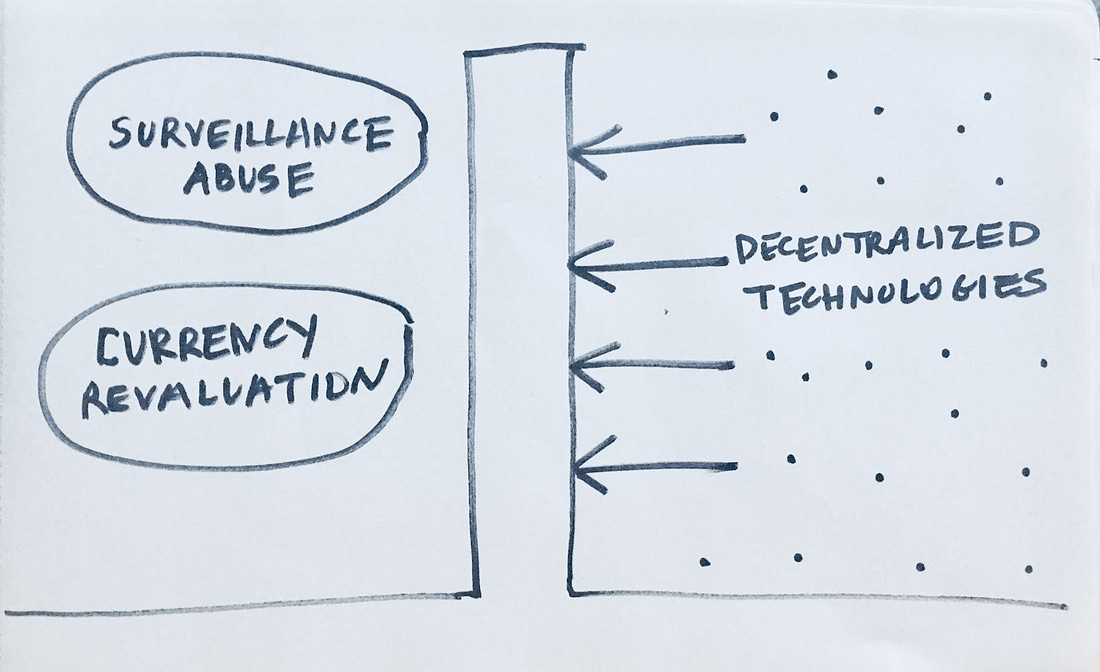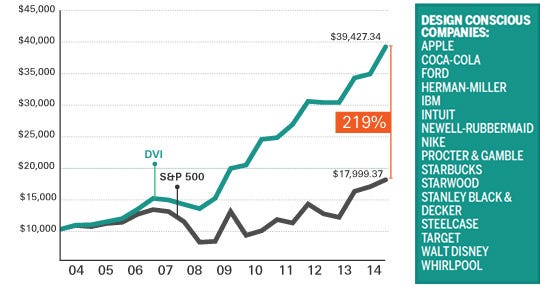Messari’s Unqualified Opinions Issue #3
TLDR:
The world’s got problems. Crypto can facilitate solutions, but broad adoption of decentralized technologies hinges primarily on fixing usability and design in the industry - something that’s in shockingly short supply today. We can quantify the outperformance of companies that win on design, and the same will likely prove true for crypto communities. But what is design, really? In crypto, it’s a usability battle that’s as much as about designing for the wider ecosystem’s future needs as it is about today’s user needs.
Today’s UO is from our head of design, Faye Hays. It’s a great piece that we’ve thought about a lot internally. It’s also issue #3 of the new newsletter. We think we’re picking up momentum, but need your feedback! What do you like and dislike? Reply directly to this email, and help us design the best newsletter in crypto. Otherwise, have a great weekend. We’ll see you Monday.
-TBI
Crypto Design 201
Usability in crypto is a two-pronged battle: one at the product level and one at the ecosystem level. How do we design for both?

The event included a panel discussion titled “Why Decentralization Matters,” organized by Alex Gladstein and moderated by Laura Shin. Panelists included Megha Rajagopalan of Buzzfeed News, Venezuelan designer/engineer Alejandro Machado, and crypto entrepreneurs Andy Bromberg of Coinlist and Amber Baldet of Clovyr.
Megha and Alejandro shared their experiences in places where the consequences of weak privacy and central bureaucratic shortcomings are all too tangible - even deadly. Amber emphasized that in the pursuit to thwart authoritarianism, how you build software matters. Andy noted that building tech for tech’s sake is not enough, just as developing a revolutionary medicine is useless if it never makes it into people’s hands.

Aka design.
Obvious premise: Broad crypto adoption won’t happen until decentralized tech has comparable usability to existing tools, and we won’t get meaningful impact from these innovations until we achieve widespread adoption.
Obvious problem: Usability is a key focus of designers, but crypto has a shortage of designers. How do we bridge the gap?
Maybe we can start by boiling things down to the dollars and cents at stake.
Generally in tech, designers are typically hired later in the process of a company’s development, and aren’t always included in the decision-making phases of product development. This is especially true in crypto, despite ample evidence that design-focused companies enjoy a critical competitive advantage.
The UX fund, a 2006 grouping of ten companies with good user experiences, generated 450% returns over a 10-year period versus NASDAQ’s 93.2%:
In a study by the Design Management Institute, a market capitalization-weighted index comprised of design-driven companies showed 10-year returns of 219% over the S&P 500:

[TBI Note: That’s a lot of alpha. *writes reqs for two more designers*]
To put things in more human terms (as designers do), Lyft’s approachability helped people start to trust ride-sharing. Airbnb (RISD founders!!) enriched people’s travel experiences by making apartment rentals feel like crashing with a friend. Nest gave folks a way to check on their dog from work (that’s what I do, anyway).
These public outperformers and private unicorns were all propelled by good design. Crypto projects would do well to learn from their great centralized counterparts.
Especially since the need for design may be even greater in crypto given how teams are attempting to rethink foundational elements of society like the essence of money, value, and trust itself.
Great, but isn’t design still just about making things pretty after the MVP has been built? Shouldn’t it come later?
No. Steve Jobs put it best: “Design isn’t just what it looks like and feels like. Design is how it works.” It’s integral to good companies and good products.
Design is figuring out which problems to solve and how to solve them. Design is using empathy to listen deeply, challenge assumptions and make innovative leaps.
Design is shaping how you experience a product *and* how that product affects your wider experiences.
Design is a verb before it’s a noun.
Design thinking has given us a richer way to accommodate the needs, goals and desired behaviors that drive a product or organization’s appeal and usefulness. The process of thoughtful ideation, iteration, prototyping and testing in rapid succession not only synchronizes well with agile development environments, it allows more inclusion from stakeholders and end users, more creativity from synaptic brainstorming, and more testing of the assumptions we often take for granted.
[TBI Note: Synaptic brainstorming will be my new differentiating term for being a design thought leader…even though I’m not.]
But before you go hire a designer for the sake of checking a box, you need to understand designers aren’t one-size-fits all.
There are UX Designers, Interaction Designers, Visual Designers, User Researchers, Data Analysts, and Strategists. In addition to these specialities there’s a holistic all-in-one type called a Product Designer.
The kind of design that will help your project get where you want it to go will operate at three levels simultaneously: the visual, the usable, and the systemic.
Let’s parse those…
Design Level I: Visual Resonance
Despite the many gifts of design thinking, it’s often difficult in tech to argue for the multifaceted role of design when its most visible and tangible manifestation is in the visual realm.
In a way, the aesthetic talent that gives designers a voice in the room can also be the thing that shoots us in the foot.
Visually engaging interfaces get first place in the race for people’s attention because visual perception has long been our way of making sense of the world. Visual information is critical as a sensory input, a communicator of tone, and a tool that enables higher powers of cognition, critical thinking and creativity. It’s the first place digital products can connect with people, relay a message and inspire community.
That said, visual resonance is only one aspect of a holistic designer’s toolkit.
Associating design only with the aspects of composition and materiality is like associating a doctor only with their ability to put on a bandaid. Ideally, your doctor not only has a broad enough understanding of the human body to keep you intact internally and externally and cure ailments, she’s also driven by a deeper purpose of ensuring your overall health and holistic wellbeing. The kind of “doctor” we need in the decentralization landscape treats an individual patient holistically, diagnoses wider trends in health, and helps to shape widespread awareness and innovation.
[TBI Note: Love this, but Faye is being charitable. Most crypto projects need tourniquets more than bandaids. We need design combat medics before surgeons.]
Design Level II: Usability Plus
Usability is the ease with which a tool can be learned and used. It’s equally important to design how it can come to be cherished and valued. Crafting usability requires a combination of empathic intuition and perceptive observation.
Anticipating, designing for, and assessing the value that people experience around a product is not as easy as it might sound.
If you’re trying to ascertain whether a dog is delighted or not, it’s easy. Is his tail wagging? He’s delighted.
Human beings are not so transparent.
Making usable and valuable products that people love often involves making things people don’t know they need, and implementing in ways you can’t know are right for that particular context until you experiment, innovate, and assess. (Designers often get things wrong, but we’re pretty good at learning from our mistakes.)
Given the complex processes required to interact with blockchain technologies, usability is a particularly tricky goal to achieve for crypto projects. What is usable for existing technologies is not necessarily optimal for decentralized technologies.
Yet many dApp solutions I see are near exact copies of their non-blockchain equivalents. If blockchain is redefining value and the role of trust in exchanges, we probably need to redefine usability in digital experiences as well.
Design Level III: Systemic Impact
This may be the most under-appreciated aspect of design in crypto.
The arguments touting the relevance and impending ubiquity of blockchain technology are many. As Andy pointed out at OFF, it’s unique that one technology could address problems as diverse as privacy abuse and currency revaluation.
Like any new tech, though, crypto is a field that can be adapted for misuse as often as it is for its loftier applications. The usability battle in the crypto space is as much as about designing for impact across a global ecosystem as it is designing products that work well and resonate with early adopters.
We must design resonant, usable, scalable products that honor all of the human beings using them, not just those with early access.
We must parse clouded motivations and hard-to-decipher data so that anyone can unpack them.
We must communicate the ecosystem’s underlying principles and benefits to a wider audience - not just a Silicon Valley echo chamber.
We must encourage people to reclaim their agency.
Discussions like the one at the Oslo Freedom Forum present an opportunity for diverse groups to assemble and think carefully about creative, long-term solutions to the world’s biggest problems.
China is becoming a panopticon. Millions are starving in Venezuela. Billions still lack access to basic financial services, while inequality continues to stretch further even in “advanced economies” like the U.S.
A lot is riding on fixing crypto’s design foundations.
So let’s figure this shit out.
-Faye @ Messari
Head of Design at Messari + Artist
News & Analyses
Messari Compression Algorithm
Content and thoughts from around the web as summarized by the Messari team.
🖼️ [Analysis] Introducing a Crypto Benchmark Framework - Vision Hill Advisors
Vision Hill Advisors has introduced a benchmark framework for the cryptoasset industry. According to the report, crypto hedge fund managers outperformed bitcoin by 560 bps during the second quarter of 2018. Based on 35 data points, Vision Hill found that the median quarterly return for managers was -4.3 percent during Q2’18, whereas bitcoin’s quarterly return amounted to -9.9 percent over the same period. The median return for passive indexing strategies was -4.4 percent while long/short funds returned 5.3 percent. Vision Hill plans to track crypto funds across five segments: fundamental, quantitative, venture, smart beta, and opportunistic on a quarterly basis. ( Messari | Source)
[TBI Note: There may have been sampling bias if underperforming funds were more reluctant to participate.]
🔁 [Analysis] The Narrative Bubble Loop - Tony Sheng
If history provides any indication, the recent rise and fall of cryptoassets will not be its last bubble according to Tony Sheng. These periods can be driven by narrative, which Jeff Tong describes as "a cohesive story or account of events, experiences, or phenomena, whether true or fictitious." Bubbles tend to form around periods where:
Investors have a lack of reliable or relevant historical data to form valuations
Conditions that attract retail investors, oftentimes poor regulation
The relative strength of narratives are able to grab attention in an opportunity-rich investment environment
From here we get mass movements, where true believers back their respective assets and discourage others even if they are not directly competitive. This conflict is particularly visible at the tail end of a speculative bubble, as the true believers of a movement stick around despite falling asset prices, hoping to build a foundation for the next group. The end of a bubble becomes a time for adherents to test beliefs, and help build the foundation for the next cycle. ( Messari | Source)
✂️ [Analysis] A Brief Study Of Cryptonetwork Forks - Alex Evans
Forks are as ubiquitous as they are misunderstood according to Alex Evans. Forks can be broadly separated into two categories. Chain forks are where the code, ledger, or both are altered, creating a new network separate from the parent chain called a child chain. Code forks, on the other hand, involve tweaking a blockchain's code offline and releasing a separate network with a new genesis block. To date, there have been hundreds of forks, with at least 40 chain forks and numerous codebase forks coming from Bitcoin ($BTC) alone. Through a study of multiple parent and child chains, Placeholder found that:
The majority of child networks resulting from chain forks are in disuse and have lost significant value relative to their parent networks.
Child chains have struggled to attract demand and developer talent from parent networks. Both users and developers tend to be loyal to the parent chain.
Despite less user activity, child chains tend to trade at higher user and transaction (e.g. NVT ratio) multiples than their parent chains.
Miners exhibit no loyalty to a specific chain and make their decisions based on economics.
Early evidence shows that the concept of "forking away" network rents, with value moving to a new fork, may not be true. (Messari | Source)
Don't read that, I read it for you: Quick Bits
Choke Points (Exchange News)
🇲🇹 Binance continues to expand its operations in Malta by seeking 50 new employees for its headquarters there. (Messari | Source)
📈 Coinbase issued a response denying recent claims that it engages in proprietary trading. A recent report from the NY State Attorney General's office stated that almost 20 percent of the trading volume on Coinbase came from the exchange itself. The company claims that it doesn’t trade for its own benefit on a proprietary basis, but instead quotes prices on Coinbase Consumer and then fills the orders through the Coinbase Markets platform. (Messari | Source)
👀 Hackers steal nearly $60 million from Japanese crypto exchange Zaif. The majority of stolen assets were Bitcoin but also included Bitcoin Cash and MonaCoin. (Messari | Source)
Startup Signals (ICOs, Cryptos, and Startups)
⛏️ Bitfury announces new mining chips. The 14nm chip is customized for SHA-256 mining and Bitfury claims it can execute a hashrate of 120 gigahashes per second. Bitfury will start by integrating the new chips into its mining facilities located in Norway, Iceland, Georgia, and Canada. (Messari | Source)
The Powers That Be (Legal/Reg/Policy)
🌐 The Financial Action Task Force (FATF), which is comprised of multiple countries, will meet in October to discuss how they can update current standards to include the emerging cryptoasset class and provide recommendations for the space. (Messari | Source)
📝 SEC requests additional comments on Cboe Bitcoin ETF. The agency was clear that they are not delaying their decision, but instead seeking additional input on the 18 points outlined in the proposal, specifically asking parties to address the sufficiency of the exchange’s statements in support of the proposal. (Messari | Source)
🏛️ Members of the Senate Finance Committee and the House Ways and Means Committee have sent a letter to the IRS asking for clarity on cryptocurrency taxes. In addition, the members requested more details on a broad summons for Coinbase user data that was issued by the agency in 2016. (Messari | Source)
📝 Texas takes aim against three alleged crypto frauds, releasing three emergency orders against cryptoasset related companies that are targeting users in the state. (Messari | Source)
🇧🇷 According to a report from Reuters, Brazil's antitrust regulator, the Administrative Council for Economic Defense (CADE), is launching a probe into alleged monopolistic practices at six major banks.
"Celebrities" (Crypto Influencers)
💵 Creator of eCash announces new crypto project. David Chaum, the creator of early digital money project eCash, has announced a new cryptocurrency called Elixxir. Elixxir plans to use new public key cryptography that the team believes will increase efficiency while also increasing privacy through features used in existing crypto projects, like multi-party computation. (Messari | Source)
Did we miss something important? Send us the link, your twitter handle and your best imitation quick bits write up. If we like it, we will include your bit in the next issue (with attribution).
Community Updates
Announcements
🎧 ICYMI, we also host & produce our own podcasts on Spotify, iTunes, and Google Play.
In this week’s episode, we have on Jake Chervinsky to provide a better & easier primer to understand the major U.S. (federal and state) regulatory agencies that relate to the crypto space. Agencies covered in this episode: SEC, CFTC, FINRA, FinCEN, OFAC, CFPB, OCC, NYDFS, and NYAG.
Listen on Apple Podcasts here, Spotify here, Soundcloud here, and Google play here. Happy learning!
Community Spotlight
Dmitrii Zhelezov, a Messari community contributor, writes a primer on blockchain design and covers PoW, PoS and DAGs. Read the primer here, or a more readable version on Medium.
Shameless Plugs
We're Hiring:
We need data engineers who want to bring transparency to crypto!
Join a fast growing team in NYC; work with crypto OGs, and former Bloomberg/Palantir engineers; & access a network that sets you up for the rest of your career. Apply here!
Upcoming Travel:
Hit us up in these locations:
Crypto Springs, Palm Springs, October 3 & 4th
EthSF, San Francisco, October 5-8th
DevCon, Prague, Czech Republic, October 30–November 2nd
Join Our Community:
If you are interested in helping us crowdsource token project details, or want to join our community to share your expertise, wed love to have you on board! Take a second to fill out an application and we will get back to you soon.
Going forward, we’ll be capping new members at 15 each week to keep things running smoothly. If you haven’t heard back, you are probably in the queue.
Like what you read? Share it! Hate what you read? Let us know @MessariCrypto.



